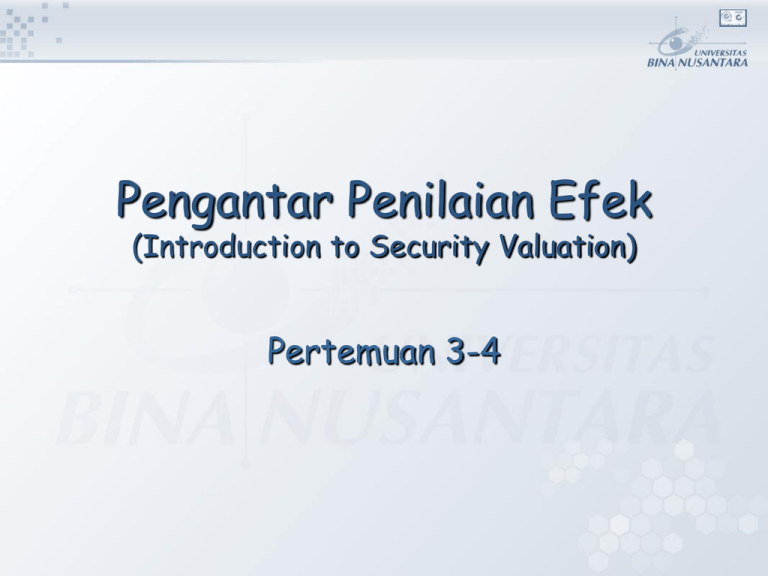Pengantar Penilaian Efek Pertemuan 3-4 (Introduction to Security Valuation)
advertisement

Pengantar Penilaian Efek (Introduction to Security Valuation) Pertemuan 3-4 Two General Approaches to Valuation Process 1. The top-down, three step approach; Start with your forecast of the direction of the general economics (Economic analysis) Based upon your economic forecast, project the outlook for each industry under review (industrial analysis) Third, within each industry, select the firm you feel will perform the best given your economic and industry forecast (stock analysis). Two General Approaches to Valuation Process 2. The bottom up, stock picking approach Selecting stock which investor believe are underpriced without considering the direction of economy and state of the industry. Fundamental differences between two approaches is how investors perceive the importance of economic and industry influences on individual stock returns Economic Analysis (1) Fiscal policy is a direct approach aimed at overall demand in an attempt to manage the rate of economic growth. Tax cut encourage spending (demand) and speed up the economy; tax increases discourage spending and slow down the economy. Government spending creates job, thus increasing overall demand. Economic Analysis (2) Monetary policy is an indirect method used by the government to manage the rate of economic growth. Decreasing the money supply cause interest rate to rise, putting upward pressure on cost and downward pressure on demand. Inflation can result from increasing money supply to fast. Rising interest rates reduces the demand for investment funds and rising consumer prices reduces product demand. Industry Analysis Consider how these industries react to economic changes. Some industries are cyclical, some are counter-cyclical and some are noncyclical. Consider global economic shifts: an industry’s prospect within the global business environment determine how well or poorly individual firms in the industry will do. Company Analysis Compare firms within each industry using financial ratios and cash flow analysis. This involves not only examining the firm’s past performance, but also its future prospects. Valuation theory The value of an assets is the present value (PV) of the asset’s expected (future) cash flows. Valuation theory study two process 1. Valuation Process 2. Investment decision process Valuation process Valuation process involves two basic steps 1. Estimate the stream of expected returns, must considered two things: 1. Form of returns, and 2. Time pattern of return 2. Estimate the required rate of return, The required rate is a function of the real rate of interest plus an inflation premium and a risk premium Returns Investment returns can take two possible forms : 1. Capital gains yield (price changes), This is the percentage increase or decrease in the price of an investment and includes gains or losses due to changes in exchange rates. 2. Current yield. Based on actual cash received during the investment horizon and is typically composed of dividends and interest. Usually stated as a percent of price and is called the coupon yield for bonds and the dividend yields for equities Returns and Investment type Common Stock Total return are Dividend yield + Capital Gains yield. Bonds Bonds that selling at par value: Total return only a coupon yield Bond that selling at premium/discount: Total return are coupon yield + capital gain/loss Preffered Stock Selling at par value return = dividend yield Selling at premium/discount return = dividend yield + capital gain/loss EXAMPLE 1 (estimate the stream of expected return) Calculate the expected returns for the stock. Its current price is $ 25. Its next expected dividend is $ 1. And you expect to sell it for $ 27 in one year. Answer: Dividend yield: D1/P0 = 1/25 = 0.04 = 4% Capital gains yield = (P1/P0) – 1 =(27/25) – 1 = 0.08 = 8% Total expected returns =Dividend yield + capital gain yield = 4% + 8% = 12% EXAMPLE 2 (estimate the stream of expected return) Calculate the expected return for a bond. Its current price is $ 895, the next (annual) coupon is $ 90, and you expected to sell the bond for $ 910 in one year. Answer: Coupon yield = C1/P0 = 90/895 = 10.06% Capital gain yield = (P1/P0) – 1 = (910/895) – 1 = 1.0168 – 1 = 1,68% Total expected return= 10.06%+1.68% = 11.74% EXAMPLE 3 (estimate the required rate of return) Required rate of return = Rreal rate + Iinflation premium + Prisk premium Rreal rate + Iinflation premium = Nominal RRisk free The risk premium, Prisk premium ,is a premium demanded for internal and external risk factors. Internal risk factors are diversifiable and include business risk, financial risk, liquidity risk, exchange risk and country risk. External risk factors, known as market risk factors, are macroeconomic in nature and non diversifiable. Rate of the government bond is 4.75%. The inflation prediction for this year is 1%. Risk premium calculated based on the market rate minus rate of the government bond is 2.25%. Calculate the required rate of return. Answer: Real rate = 4.75% ; Inflation = 1% Risk Premium = 2.25% Required rate of return = 8% The required return on Common stock The required return on a stock (ke) is usually estimating using the capital asset pricing model (CAPM) ke = Rrisk free + Betastock(Rmarket – Rrisk free) Investment decision process Once the value of the assets has been estimated, compare it to the current market price. > market price BUY If estimated value < market price DON’T BUY If estimated value



